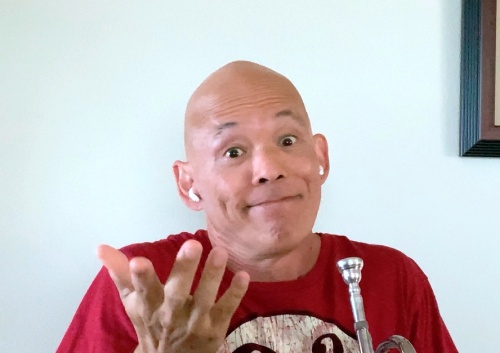How To Play Trumpet
Down the bunny trail. Hippity hoppity. The “fix trumpet embouchure” bunny trail. Or is it the “how to make a trumpet embouchure” bunny trail? Does it feel like I’m stuck here? Well, yea. I had such high hopes of a “comeback”. To be able to play the trumpet at least as well as I did in high school. Expectations? Meet reality. That’s because I’ve been cheating. I’ve been using my old trumpet embouchure. My old face. I tried to use different muscles with the “relax and blow” trumpet playing technique. That change wasn’t as bad as the bunny trail I’ve just started down. Please keep your hands and arms safely within the ride. It’s going to be a bumpy ride.
Patience is a virtue.
And a donut without a hole is a danish.
Mouth position for trumpet
Bass ackwards. That’s what it feels like. Trying to align my jaw to support my lips (way easier to type and say than embouchure). With the lower teeth behind the top, I used my upper lip. It was where everything came from. Turns out, with the teeth aligned, I gotta brace the mouthpiece against the lower lip. It’s not used to that. Letting the upper lip go with almost no pressure is weird. And crappy sound. Crunchy is the best description.
It can’t be me, gotta be the gear right? So I tried a bigger trumpet mouthpiece (had a 1C from 8th grade laying around). One that has a larger rim diameter (over 17.00 millimeters) so more of my lips fit. It also has a deeper cup and a more rounded inner rim than my “other” trumpet mouthpiece. Okay. Not much change. Then I tried a “smaller” mouthpiece. One with a smaller cup diameter (16.50 millimeters) . I’m purposely not telling you what I used. Mostly because you’d just laugh. Seriously. You’d laugh. Hard. Okay. Here’s a pic so you can see the differences.

I don’t recommend making this drastic of a mouthpiece change if you are able to play now. Small changes are better. I’m trying to figure out what I need to get a trumpet note out. That’s probabaly not your problem when you go on a “mouthpiece safari” like I did. Then I went back to old faithful. Same. After all that, the gear didn’t make a difference. The person in the mirror. It’s his fault. Patience is what again?
Trumpet embouchure
Last week I left off with an interesting paper. Then I found YARP (see last week’s post for the definition of that FLA). Sorry, Four Letter Acronym. This one was by a French horn player. One of the more successful members in the band started with French horn. When she moved to trumpet, she found it almost easy. Don’t you just love people like that? Great sound, full upper register. She also practiced night and day. When not practicing, she studied music theory. Ah, so that’s how people develop their musical gifts. You know, the ones I don’t have? Back to the YARP. This person worked with Philip Farkas, the guy that wrote “The Art of Brass Playing” when he was having embouchure problems. After comparing this and the other information, the thing that was “common” was:
- The lower jaw has to move forward to align with the upper teeth. This gives both your lips even support to make a solid embouchure
- Place the mouthpiece on the lower lip first. This lets you put adjust the pressure on the upper lip to make a good seal. The less the better as the “proper brass instrument embouchure” should only have enough mouthpiece pressure to make a seal against the lips.
Where did I hear that before? This was what Charlie Porter said in his “Finding your natural jaw position” YouTube video. From the previous posts, his embouchure video shows the teeth need to be lined up.
This video didn’t make sense to me at first. But I was only able to get “crunchy” notes out so “setting” the mouthpiece on the lower lip first and rolling up to find where it sounds good makes sense. Patience is a virtue? How about annoying. That’s it. Patience is annoying.
Messed up lips
Ever try to eat with your “other” hand? You know, the one you don’t normally use? Like if you are right-handed, try eating with your left. Weird huh? It feels weird. Feels odd. You just aren’t used to it right? That’s how placing the mouthpiece on my lower lip first was. Then I tried to put “equal” pressure on both lips, even a little more on the lower lip. It felt weird. Felt odd. How come? It’s because having my lower lip being behind my upper all those years meant it never felt any pressure. Any pressure felt like too much. “Ah ha”. Putting pressure on my lower lip let my upper lip be freer. I started to be able to play longer because my upper lip didn’t get tired so quickly. But wait, there’s more.
Stiff upper lip
That’s what the British say (I think) to “be strong” in the face of adversity. In my case, it means I’m not using the right muscles. Yep. After 5 weeks of getting nowhere fast, I signed up and took an online trumpet lesson. I was just frustrated. I won’t say who it was, but the 1-hour session was less than $50 and pretty life changing. He asked what I’d be working on. I said Trumpet Scales and Lip Slurs. I talked to him about what was going on, and he asked me to play a little. I played the “C” scale from below the staff to the middle of the staff. My trumpet teacher heard me running into the “static” or “crunchy” notes as I got to the “C” in the middle of the staff. He said “First, stop doing that other stuff, let’s get back to real basics”. He explained I was still using my checks to pull my lips apart (he saw that when I inhaled. The next one, and this was a biggie, I wasn’t using my Levator labii superioris muscles. My what?!
Palm? Meet face. Hard. Ever see a picture of Elvis Presley doing his upper lip lift? The muscles I use to lift my upper lip when I brush my teeth are the ones. My trumpet teacher said do this, like Elvis, but both sides. Fail. Didn’t know how to move them. What Elvis and the young lady above are showing the LLS muscles. They form the lines that start just outside your nose and end just above, and outside of the corners of your mouth. OMG that was a horrible description. No wonder I didn’t know what they were.
I used a mirror and touched my face (I promise, I washed my hands first) and started to engage them. He made several analogies like “make the face when you smell something bad” and that was the one that hit home. This is what a great trumpet teacher do. They explain things in a way that makes sense. Do that while leaving the corners of my mouth relaxed. Oh, and don’t wrinkle your nose as those are other muscles. Wait what? The “homework” my trumpet teacher gave me was to strengthen those muscles. They hold the upper lip taught against my teeth which allow my lips to vibrate. No trumpet. No mouthpiece. Try and buzz. Took me three full days of just flexing my LLSMs or my “Elvis face” muscles as I call em. The fourth day, I could buzz a little. The 6th day, I could even buzz on my mouthpiece. I know, he said leave it. But I had to try. What a difference. Okay, wanna see a how a professional trumpet player does it? One that is about 18 years old when this was recorded?
I’ve watched her full performance so many times. Please watch it. I’ll wait here. I missed her setting her embouchure. Every single time. Did you see how she set her embouchure during her solo played at normal speed? Please let me know in the comments.
And that my friends is what is needed when you run face first into a wall. At full speed. After reading a ton of stuff, watching YouTube after YouTube, I didn’t find the changes I needed to make to become a trumpet player. I have to overcome my old “muscle memory” and do something very different. And the only way to figure out what, was to find a trumpet teacher that could hear and see what I was doing. Wrong that is. What I was doing wrong. Then they taught me. Showed me a path forward. Patience may be a virtue, but knowing when to call in an expert, is virtuous. Or is it just plain smart? Well, you know that’s not me.


